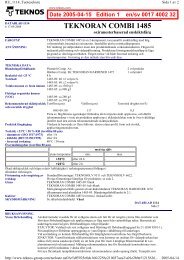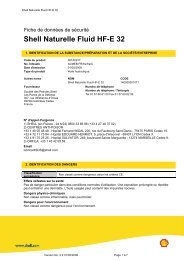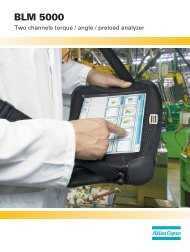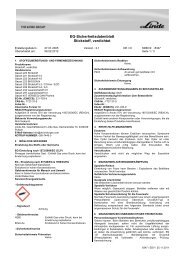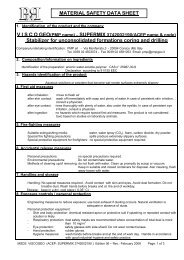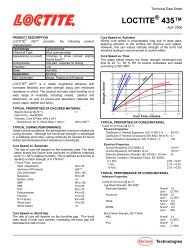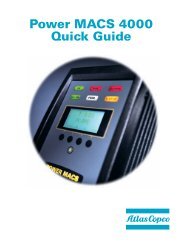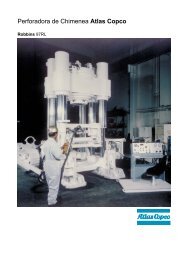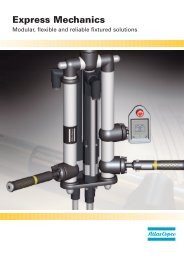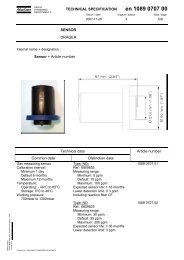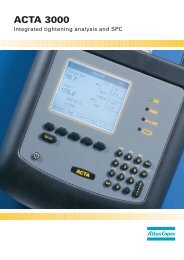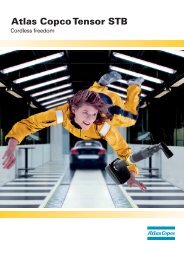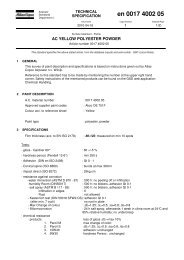Ergonomics - Atlas Copco
Ergonomics - Atlas Copco
Ergonomics - Atlas Copco
You also want an ePaper? Increase the reach of your titles
YUMPU automatically turns print PDFs into web optimized ePapers that Google loves.
164<br />
operator equal to installed torque divi-<br />
ded by the distance from the spindle to<br />
the center of the handle. In this case:<br />
28/0.270 = 104 N<br />
Palmar flexion torque during tightening<br />
equals the pull force (104 N) multiplied by the<br />
height of the angle head above the bolt head.<br />
In this case: 104 N • 0.03 m = 3.1 Nm<br />
Supination torque when entering the bolt<br />
is the distance from mid-handle to center<br />
of gravity, times weight, times gravity.<br />
In this case: 0.1 m • 1.45 kg • 9.81 = 1.4 Nm<br />
When the tool is picked up from the tool rest<br />
the radial flexion torque can be calculated in<br />
the same way as the supination torque.<br />
WEIGHT<br />
The angle nutrunner is a typical assembly<br />
tool, and weighs 1.4 kg. Thus, the score is 11.<br />
TEMPERATURE<br />
A typical tightening cycle lasts 2 seconds.<br />
In an 8-hour working day, the average tool<br />
running time is normally 2 hours, resulting<br />
in a work cycle time of 8 seconds. The tem-<br />
perature in the handle, measured with the<br />
tool in a brake running at maximum capac-<br />
ity on a soft joint, was 15ºC, thus scoring 4.<br />
SHOCK REACTION<br />
The shock reaction from an angle nutrunner<br />
depends to a large extent on the joint, i.e.,<br />
whether it is a hard or a soft joint, or some-<br />
where in between. It also depends on the op-<br />
erator’s posture, whether the operator’s hand-<br />
arm is in line with the motion of the handle, or<br />
perpendicular to the motion. All these factors<br />
influence the magnitude of the impulse from<br />
the joint reaction that tries to rotate the tool.<br />
For the purposes of evaluation we use the<br />
impulse measured in accordance with ISO<br />
6544 with a torque setting of 28 Nm. The<br />
impulse is 2.0 Ns, resulting in a score of 2.<br />
This is not taken into account in the<br />
evaluation since we based it on a soft joint<br />
and the torque reaction is evaluated as a<br />
load on the operator.<br />
VIBRATION<br />
During the development of the vibration test<br />
codes for declaration purposes it was found<br />
that, in all tests, angle nutrunners had<br />
vibration values below 2.5 m/s 2 . The Machine<br />
Directive stipulates that if the vibration value<br />
is below 2.5 m/s 2 , this fact should be stated. In<br />
other words the manufacturer is not obliged to<br />
give the actual value. The Standards Commit-<br />
tee decided not to develop a test code for angle<br />
nutrunners. The manufacturer must, however,<br />
be sure that the value is less than 2.5 m/s 2 . To<br />
estimate vibration during use, here again it is<br />
recommended not to use any correction.<br />
a (8) = (2/8) 1/2 • 2.5 = 1.3 m/s 2<br />
The score is thus 9.



